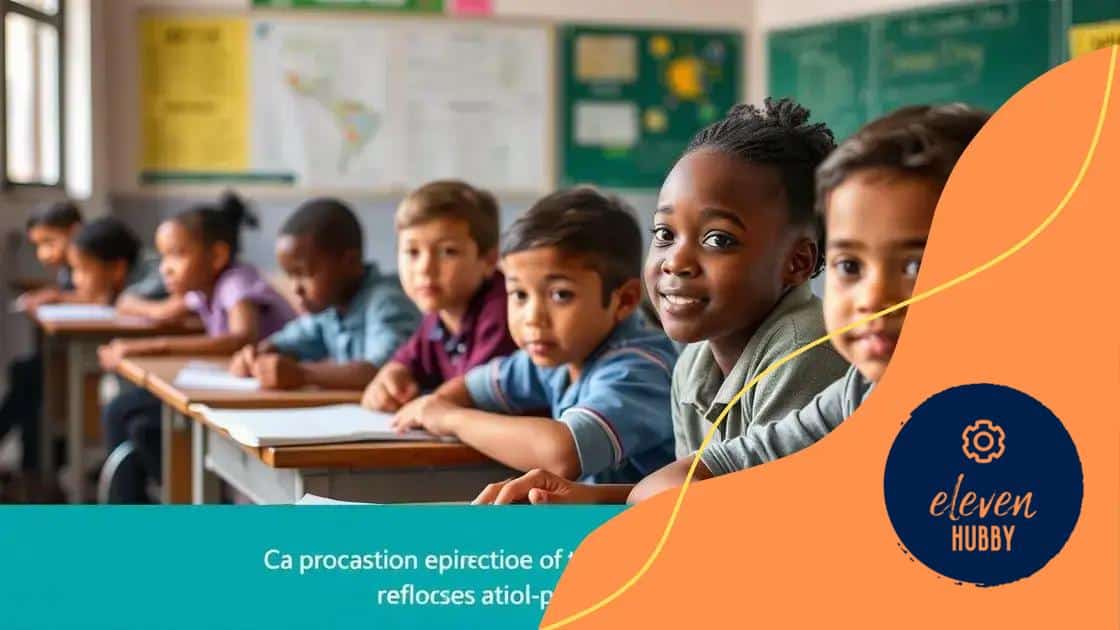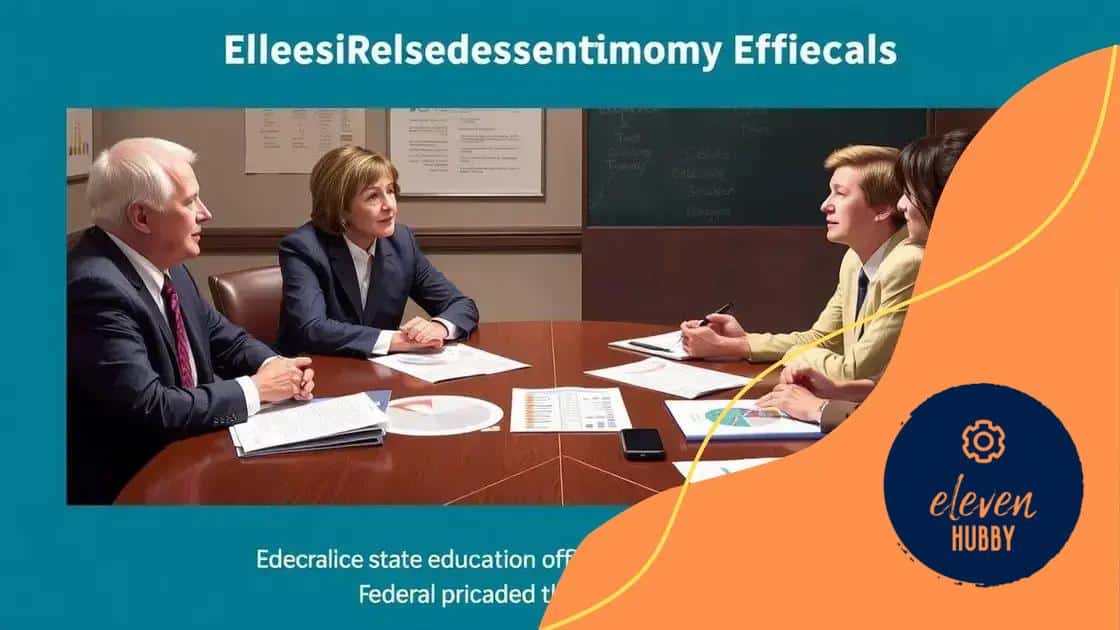Federal policies reshape education: what’s changing?

Engaging local communities for educational improvement involves collaboration between schools, parents, and businesses, enhancing resources and support to create better learning environments for students.
Federal policies reshape education in ways that many may not even realize. Have you wondered how new regulations affect what happens in classrooms? Let’s dive into the changes and their implications.
Understanding the role of federal policies in education
Understanding the role of federal policies in education is essential to grasp how our schools operate. These policies guide funding, curriculum standards, and teacher qualifications. They influence every aspect of the educational landscape, impacting students from diverse backgrounds.
Federal involvement in education began with laws like the Elementary and Secondary Education Act (ESEA). This legislation aimed to ensure that all children have equal access to quality education. Over the years, policies have evolved, addressing the needs of various student populations.
Key Objectives of Federal Education Policies
One core goal of these policies is to promote equity in education. This means that all students should receive a fair opportunity to succeed. Federal policies provide funding to support underfunded schools, which is crucial for leveling the playing field.
- Provide resources for low-income schools.
- Implement programs for special education.
- Support bilingual education initiatives.
Another important objective is to improve educational standards. The federal government works to create assessment systems that measure student performance across schools. This data helps identify areas needing improvement, allowing schools to enhance their educational approaches.
Moreover, federal policies emphasize teacher quality, recognizing that skilled teachers are vital for student success. Programs are in place to support teacher training and development. This focus ensures that educators are equipped with the skills needed to foster positive learning environments.
The Impact on Local Education Systems
While federal policies set broad guidelines, their implementation is often localized. State and district leaders adapt these policies to meet community needs, which can result in significant variations across the country. This flexibility allows for innovation but can also create disparities in education quality.
It’s important to understand how these policies influence daily classroom experiences. For instance, federal funding may lead to smaller class sizes, enabling personalized attention for students. This environment can enhance learning outcomes significantly.
In conclusion, the role of federal policies in education is multifaceted. They aim to foster equity, improve standards, and enhance teacher quality, ultimately shaping the educational experiences of students nationwide.
Key recent changes in federal education policies
Key recent changes in federal education policies are reshaping how schools function across the nation. These changes are designed to improve educational outcomes and ensure that all students have access to quality learning experiences. Understanding these shifts can help clarify the direction education is heading.
One significant development is the emphasis on accountability. Schools are now required to demonstrate improved student performance through standardized testing. This measure aims to hold schools accountable for the education they provide and ensures that students are meeting necessary benchmarks.
Increased Funding for Underfunded Schools
Another recent change involves the allocation of greater federal funding specifically aimed at underfunded schools. This funding aims to bolster resources in low-income areas, helping schools acquire the tools and materials needed for effective learning.
- Targeted grants for essential supplies.
- Support for updated technology in classrooms.
- Investment in teacher training programs.
Moreover, federal policies now promote personalized learning. This approach allows educators to tailor instruction to meet the diverse needs of students, recognizing that each learner is unique. Schools are encouraged to adopt innovative teaching methods that cater to different learning styles.
Additionally, there has been a shift in focus toward social-emotional learning (SEL). Federal policies are increasingly prioritizing the mental health and well-being of students, understanding that emotional support is critical for academic success. Programs designed to foster SEL are being implemented in many classrooms across the country.
Support for Diverse Learners
Changes also include stronger provisions for students with disabilities and English language learners. Federal policies now require schools to provide appropriate accommodations that ensure these students can learn effectively alongside their peers. This includes special programs tailored to meet their specific needs.
Overall, these key recent changes reflect a commitment to improving education for all students. By focusing on accountability, funding, personalized learning, and social-emotional support, federal education policies are evolving to create a more equitable and effective educational system.
Impact of federal policies on state education systems

The impact of federal policies on state education systems is significant and multifaceted. These policies shape how states allocate resources, implement curriculum standards, and measure school performance. Understanding this influence helps in grasping the broader implications for education at both state and national levels.
One primary way federal policies affect state systems is through funding. States often rely on federal grants to support various educational programs. This funding can target specific needs, such as enhancing technology in classrooms or providing additional support for low-income students. Federal financial assistance helps states bridge funding gaps and improve educational priorities.
Standardization of Educational Standards
Another critical impact comes from the push for standardized educational benchmarks. The federal government encourages states to adopt similar testing and assessment methods. These standards aim to ensure that all students receive a quality education, regardless of where they live.
- Development of state-level assessments aligned with federal guidelines.
- Emphasis on educational outcomes that can be measured uniformly.
- Promotion of accountability in local schools.
Additionally, federal policies significantly influence teaching practices within states. For example, programs like Title I aim to improve education for disadvantaged schools. This provision compels states to prioritize educational equity, leading to programs that specifically address the needs of students from low-income families.
Moreover, the impact extends to professional development for teachers. Federal funding often supports training programs that enhance teacher effectiveness, ensuring educators have the skills necessary to meet diverse learning needs. This investment reflects a growing acknowledgment of the crucial role that teachers play in student success.
Variability in Implementation Across States
However, while federal policies set the framework, implementation can vary significantly across states. Each state has the flexibility to interpret and adapt these policies to fit local contexts. This variability can lead to unequal educational experiences for students, creating disparities between districts.
Some states excel in utilizing federal guidelines to enhance educational opportunities, while others may struggle to implement changes effectively. This dynamic showcases the complexity of federal-state relationships in educational policy, as local needs and priorities often influence outcomes.
In looking at the overall impact of federal policies on state education systems, it becomes clear that these guidelines are essential for shaping educational quality. They drive improvement efforts, create accountability, and push for innovation while also highlighting the challenges that arise from diverse implementation practices.
Future trends in educational policy reform
Future trends in educational policy reform are shaping the landscape of education in profound ways. As society evolves, so do the needs of schools and students. Understanding these trends helps educators, policymakers, and communities prepare for what lies ahead.
One notable trend is the growing focus on technology integration in schools. As digital tools become increasingly accessible, educational policies are adapting. Schools are not only incorporating technology for teaching but also ensuring that students develop essential digital literacy skills for the future.
Personalized Learning Approaches
Another trend gaining traction is the push for personalized learning. This approach recognizes that students have unique learning styles and paces. Federal and state policies are evolving to support individualized learning plans, enabling students to progress at their own rates.
- Incorporating adaptive learning technologies.
- Emphasizing student-driven projects and interests.
- Utilizing data to tailor instruction to individual needs.
In addition, there is an increasing emphasis on social-emotional learning (SEL). Educational policies are beginning to recognize the importance of mental health and emotional well-being in student success. Schools are adopting SEL programs to help students manage their emotions and develop crucial interpersonal skills.
Moreover, equity in education remains a critical focus. Future policy reforms are likely to address systemic inequalities in education. Policymakers are working towards ensuring that all students, regardless of background, have access to high-quality education and resources.
Collaborative Learning Environments
Furthermore, the trend towards collaborative learning environments is becoming more apparent. Policies are advocating for spaces that encourage teamwork and communication among students. Collaborative projects promote critical thinking and problem-solving, skills that are essential in today’s world.
These educational reforms are also being driven by ongoing research and data analysis. Policymakers rely on evidence-based approaches to guide changes, ensuring that reforms are effective and beneficial for students. This reliance on data allows for more informed decisions that align with current educational needs.
As we look to the future, it is clear that educational policy reform will continue to evolve. Embracing technology, personalizing learning, supporting social-emotional health, and striving for equity will be at the forefront of these changes, ultimately transforming the way education is delivered.
Engaging with local communities for educational improvement
Engaging with local communities for educational improvement is vital for the success of schools and their students. Community involvement helps create supportive learning environments. When schools and local communities work together, they can address educational challenges more effectively.
One way to foster this engagement is through establishing partnerships. Schools can collaborate with local businesses, nonprofits, and civic organizations. These partnerships can provide resources and support that enhance educational programs. For example, local businesses might offer internships, mentoring, or financial support for school activities.
Community Events and Workshops
Another effective strategy is organizing community events and workshops. Schools can host events to bring families and community members together. These gatherings help build relationships and foster a sense of belonging. When families are involved in educational events, students tend to perform better academically.
- Parent-teacher meetings that include community resources.
- Workshops on educational topics relevant to families.
- Cultural events that celebrate local heritage and diversity.
Moreover, schools can create advisory committees that include community representatives. These committees can give valuable feedback on school policies and programs. Involving community voices ensures that schools address the unique needs of their neighborhoods.
In addition, schools can use surveys and forums to gather input from community members. This feedback helps educators understand what improvements are needed and what resources are available. Active listening fosters trust and helps build stronger relationships between schools and communities.
Utilizing Local Expertise
Furthermore, schools can tap into local expertise by inviting community members to share their knowledge and skills. Guest speakers and volunteers can enhance classroom learning and inspire students. Local artists, business leaders, and professionals can provide real-world insights that enrich the curriculum.
By engaging with local communities, schools create a network of support that can lead to lasting educational improvements. Collaborative efforts not only enhance school resources but also promote a shared commitment to student success. Schools that prioritize community engagement are better equipped to meet the diverse needs of their students.
Involving local communities in education is crucial for improving student outcomes. When schools partner with parents, businesses, and organizations, they create a supportive environment that benefits everyone. Community engagement leads to better resources, enhanced learning experiences, and a shared commitment to success. By working together, we can ensure that every child receives the education they deserve. Let’s continue to strengthen these bonds for a brighter future in education!\n\n
\n
FAQ – Frequently Asked Questions about Engaging Local Communities for Educational Improvement
Why is community engagement important for schools?
Community engagement enhances student outcomes by creating a supportive environment and providing additional resources.
How can local businesses support schools?
Local businesses can offer internships, mentoring programs, and financial support to enhance educational opportunities.
What types of community events can schools organize?
Schools can host workshops, cultural events, and family engagement activities to foster connections with the community.
How can schools gather feedback from community members?
Schools can use surveys, forums, and advisory committees to collect valuable input from local residents.






